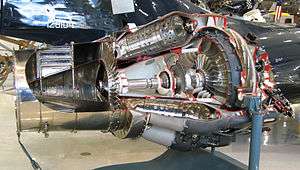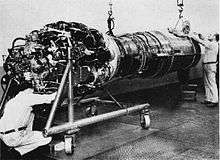Pratt & Whitney J48
The Pratt & Whitney J48 (company designation JT7 Turbo-Wasp) is a turbojet engine developed by Pratt & Whitney as a license-built version of the Rolls-Royce Tay. The Tay/J48 was an enlarged development of the Rolls-Royce Nene (Pratt & Whitney J42).
| J48 | |
|---|---|
 | |
| A Pratt & Whitney J48 | |
| Type | Turbojet |
| National origin | United Kingdom/United States |
| Manufacturer | Pratt & Whitney |
| Major applications | Grumman F9F Panther Grumman F-9 Cougar Lockheed F-94 Starfire |
| Number built | 4,108 |
| Developed from | Rolls-Royce RB.44 Tay |
Design and development
In 1947, at the behest of the United States Navy, Pratt & Whitney entered into an agreement to produce the Rolls-Royce Nene centrifugal-flow turbojet engine under license as the J42 (company designation JT6), for use in the Grumman F9F Panther fighter aircraft.[1] Concerned that the Nene would not have the potential to cope with future weight growth in improved versions of the Panther, Luke Hobbs, vice president of engineering for P&W's parent company, the United Aircraft Corporation, requested that Rolls-Royce design a more powerful engine based on the Nene, which Pratt & Whitney would also produce.
By 1948, Rolls-Royce had designed the Tay turbojet, also a centrifugal-flow design. However, as Rolls-Royce was then developing an improved design with an axial compressor, which would become the Avon, the development and production of the Tay turbojet was left to Pratt & Whitney.[1][2] However, Rolls-Royce retained the rights to the Tay outside of the United States.
The Tay/J48 was a thirty percent enlargement of the preceding Nene/J42, and was produced both with and without afterburning.[2]
Operational history
Several aircraft types used the J48 engine during the 1950s, including the Grumman F9F-5 Panther.[3] and Grumman F9F-6/F9F-8 Cougar,[4] The U.S. Air Force's Lockheed F-94C Starfire[5] and North American YF-93 used afterburning versions of the J48 engine.[6]
Variants
Data from The Engines of Pratt & Whitney: A Technical History.[7]
- J48-P-1
- 6,000 lbf (27 kN) dry, 8,000 lbf (36 kN) thrust with afterburning
- J48-P-2
- 6,250 lbf (27.8 kN), 7,000 lbf (31 kN) thrust with water injection
- J48-P-3
- 6,000 lbf (27 kN), 8,000 lbf (36 kN) thrust with afterburning
- J48-P-5
- 6,350 lbf (28.2 kN), 8,750 lbf (38.9 kN) thrust with afterburning
- J48-P-6
- 6,250 lbf (27.8 kN), 7,000 lbf (31 kN) thrust with water injection
- J48-P-6a
- 6,250 lbf (27.8 kN), 7,000 lbf (31 kN) thrust with water injection
- J48-P-7
- 6,350 lbf (28.2 kN), 8,750 lbf (38.9 kN) thrust with afterburning
- J48-P-8
- 7,250 lbf (32.2 kN) thrust
- J48-P-8A
- 7,250 lbf (32.2 kN) thrust
- Turbo-Wasp JT-7
- Commerial engines / company designation
Applications
Specifications (J48-P-8A)

Data from Aircraft engines of the World 1957[8]
General characteristics
- Type: turbojet with water injection[9]
- Length: 109.75 in (2,788 mm) without fixed nozzle
- Diameter: 50.5 in (1,280 mm)
- Frontal area: 13.9 sq ft (1.29 m2)
- Dry weight: 2,080 lb (940 kg) dry
Components
- Compressor: single-stage double-sided centrifugal compressor
- Combustors: nine interconnected can combustion chambers
- Turbine: single stage axial
- Fuel type: aviation kerosene / JP-4
- Oil system: pressure spray with scavenge at 40 psi (280 kPa)
Performance
- Maximum thrust: dry 7,250 lbf (32.2 kN) thrust for take-off; wet 8,500 lbf (38 kN)
- Overall pressure ratio: 4.5:1
- Air mass flow: 130 lb/s (59 kg/s) at 11,000 rpm
- Specific fuel consumption: 1.14 lb/(lbf⋅h) (32 g/(kN⋅s))
- Thrust-to-weight ratio: 3.57
See also
Related development
Related lists
References
- Notes
- Connors, p.202
- Gunston 2006, p.195.
- F9F Panther, U.S. Navy Historical Office. Accessed 2011-01-06.
- Bishop and Chant 2004, p. 154
- RAF Flying Review "TECHNICAL GEN" authors: staff, September 1962 p. 59
- North American YF-93A. National Museum of the US Air Force fact sheet. Accessed 2017-07-16
- Connors, p.210
- Wilkinson, Paul H. (1957). Aircraft engines of the World 1957 (15th ed.). London: Sir Isaac Pitman & Sons Ltd. pp. 98–99.
- Wilkinson, Paul H. (1955). Aircraft engines of the World 1955 (13th ed.). London: Sir Isaac Pitman & Sons Ltd.
- Bibliography
- Bishop, Chris; Chris Chant (2004). Aircraft Carriers: The world's greatest naval vessels and their aircraft. Minneapolis, MN: Zenith Press. ISBN 978-0-7603-2005-1.
- Connors, Jack (2010). The Engines of Pratt & Whitney: A Technical History. Reston. Virginia: American Institute of Aeronautics and Astronautics. ISBN 978-1-60086-711-8.
- Gunston, Bill (2006). World Encyclopedia of Aero Engines, 5th Edition. Phoenix Mill, Gloucestershire, England, UK: Sutton Publishing Limited. ISBN 0-7509-4479-X.
- Kay, Anthony L. (2007). Turbojet History and Development 1930–1960 Volume 2:USSR, USA, Japan, France, Canada, Sweden, Switzerland, Italy and Hungary (1st ed.). Ramsbury: The Crowood Press. ISBN 978-1861269393.
External links
| Wikimedia Commons has media related to Pratt & Whitney J48. |